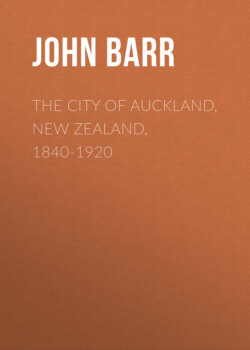Читать книгу The City of Auckland, New Zealand, 1840-1920 - John Barr - Страница 8
На сайте Литреса книга снята с продажи.
THE EARLIEST INHABITANTS OF TAMAKI
ОглавлениеAncient Maori culture did not embrace the knowledge of letters. We therefore possess no written records of the pre-European times. Our information is confined to the tribal folk-lore and folk-songs of the people.
We do know, however, that from a very remote past the Pacific had been peopled by races of a more or less Polynesian type, and that branches of these had also reached New Zealand.
Legend tells us that the earliest settlers in Ao-tea-roa were a race of giants—the “Kahui-tipua.” Of that ilk was one Mata-aho, who had no doubt arrived from lands of a more genial temperature. He called upon his Fire-Goddess (Mahu-ika) to produce subterranean fires to warm his limbs. Hence the volcanic outbursts which have left evidence of the efficiency of that ancient invocation in the form of the extinct volcanic cones and lava flows of the Tamaki Isthmus.
Then, again, there was an equally ancient, but more human-like people resident hereabouts—the “Patu-paiarehe”—so-called “Fairies,” from whom, indeed, many of the leading chieftains of to-day proudly claim descent. Concerning these people we are told of their industry in the arts of peace, fishing, hunting, weaving, etc.; nor were they, it would seem, deficient in the sterner art of war, for they were involved in much inter-tribal strife. One of these struggles resulted in a weaker faction deciding to emigrate across the Waitemata. In order to do so they began to erect a stone causeway. However, the sun arose on their uncompleted toil, and dried them all up! The ruin of this ancient attempt to bridge the Waitemata remains to this day in the form of that long reef “Te Toka-roa,” off Point Chevalier. The unsentimental geologist will tell you it is actually an old lava flow from Mount Albert.
Despite the mists of legendary lore which surround the doings of these ancient people, both “Giants” and “Fairies,” it is probable that they had actually existed here. They were, perhaps, the earliest of the immigratory races which were continually arriving. Over the Pacific Ocean canoe voyages were taking place in all directions. The motive which impelled these undertakings was doubtless that stated in the legends—overpopulation involving warfare, causing the weaker factions to seek safer homes over the water to live in. No doubt the food supplies of over-populated islands also necessitated sections of the people to swarm off; the mere spirit of adventure, ever in the human heart, was probably an important contributory cause.
Whoever these ancient people were—and the probability is that they were Polynesians similar to the immigrants of a later time—they were a numerous people who “covered the land like ants”; such is the proverbial description of them.
II
Toi-te-huatahi[1]
Some time about 1150 A.D. there arrived in New Zealand a chief named Toi-te-huatahi, the leader of a large immigration, who settled at Whakatane, and his people, known as Te Tini-o-Toi, rapidly spread throughout the land, conquering or merging with their predecessors. Tamaki was soon populated by them. Oho-mai-Rangi, said to be a son of Toi, lived at the Waikato Heads, and to him is generally attributed the tribal name “Nga-Oho”—a people of Toi who occupied a wide area in the south, Waikato and Tamaki. A great-grandson of Toi was one Kauea, who carried the conquests of his people into the Kaipara and the far north.
By the middle of the fourteenth century we find the Nga-Oho dominant over all this area, having various sub-tribal names, such as the Nga-riki, Wai-o-hua, etc.
